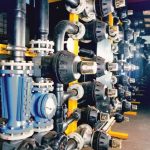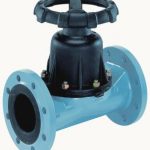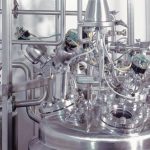Whenever high purity or very corrosive media or media containing solids in suspension have to be conveyed and dosed in chemical processes, diaphragm valves are the first choice. The greatest advantage of this valve design is that only valve body and diaphragm come into contact with the medium. Particles are safely enclosed by the soft diaphragm and carried off when the valve is opened.
Rodolfo Eisermann
When observing a rubber hose, an English mining engineer working in a coal mine in South Africa at the end of the twenties had an idea: If you bend the hose, the flow of the medium is completely shut off, if you release it, it returns to its original state without being damaged. Based on this observation the engineer developed the diaphragm valve. The principle of a diaphragm valve is simple. It consists only of three main components: valve body, diaphragm and actuator or manual bonnet. Usually the body is a 2/2 way body independent of the flow direction, and at its centre is a weir. The diaphragm is pushed onto the weir by a compressor which is connected to the actuator or bonnet via the valve spindle, thus closing the valve.
Correct material match
Valve body as well as compressor and actuator/bonnet are manufactured from cast iron, S.G. iron 40.3 or various stainless steels depending on the application. To increase the valve service life in applications with corrosive chemicals and abrasive media bodies are lined with natural rubber and synthetic rubbers or chemically resis-tant plastic materials such as PP, PTFE, ECTFE, PFA as well as glass. Valves with thermoplastic bodies are used in special applications involving e.g. corrosive or high purity media. These bodies are mostly manufactured from PP, PVC, PVDF or PFA. Diaphragm materials are EPDM, Butyl, Neoprene, Hypalon, Perbunan as well as fluoroplastics such as PTFE and FPM. When designing diaphragm valves, the materials of lined or unlined valve bodies and the diaphragm must match. Only if the thermic, mechanical and chemical resis-tance of these materials is similar can a long service life be ensured.
Low maintenance requirements
Diaphragm valves are unique due to the following features: The diaphragm can be replaced with the valve in-line. This is a great advantage particularly with welded-in valves and large nominal sizes. The diaphragm change only takes a few minutes. No other seals have to be exchanged. Thus the maintenance requirements are low. In small nominal sizes the initial cost and maintenance are more cost effective than other valve types. This is particularly true for high-grade lined versions. The valves can be used at working temperatures ranging from -10 to +160 °C depending on valve body, lining and diaphragm material. DN 4 to DN 350 are standard nominal sizes. Some of the features of the individual valve types can be improved by special measures.
These advantages, however, have a few limitations. Diaphragm valves are suitable for use with working pressures up to 10 bar, dependent on their nominal size and in rare cases up to 16 bar. With larger diameters the permissible working pressure may only be 3 bar.
Use with corrosive media
Diaphragm valves can be used in about 90 % of all industrial applications. A few examples are set out below. Dependent on their design, the Gemü 620 and 675 dia-phragm valves are particularly suitable for high purity to heavily contaminated liquid and gaseous media. Versions with PFA lined valve bodies in S.G. iron or stainless steel are preferred for mineral, oxidizing and inorganic acids. These valve designs are also resistant to bases, halogens, metal salts, hydrocarbons, alcohols, aldehydes, ketones, ethers and ammonia. PFA is very resistant even at elevated temperatures. The use of a stainless steel body provides additional safety in case the lining gets damaged or in case the valve is subject to a corrosive ambiance. Dual-layer PTFE/EPDM diaphragms are mainly used. The PTFE face is used on the medium side whereas EPDM is used as backing material for mechanical reinforcement. This enables the rigid PTFE face to be made thinner and to be mechanically deformed.
Sulphuric acid is used as an example to show that lining materials may vary according to the application. In applications with oleum and 100 % concentration PFA lined bodies and PTFE/FPM diaphragms are preferred. With 80 % acid more cost effective PP lined bodies and PTFE/EPDM diaphragms can also be used. With 50 % concentration hard rubber can be selected as lining material for the valve bodies and dual layer PTFE/EPDM diaphragms can be employed.
Particulate media
In water treatment and waste water disposal applications where the particle load (e.g. sand and slurry) can be quite high Gemü 655 or 656 full bore diaphragm valves are the ideal solution. The particles are enclosed by the diaphragm which enables the valve to be completely sealed and thus further medium cannot flow in. Diaphragm valves are installed upside down in applications with media where the carried particles tend to deposit and condense on the upstream side directly on the diaphragm. When the valve is opened again, the caking is broken open by the movement of the diaphragm and is carried off. In contrast to other diaphragm valves, full bore diaphragm valves have no weir but a free passage, similar to gate valves or ball valves. Thus they provide considerably higher Kv values at the same nominal sizes. These valves should only be used for low cycle duties due to the high mechanical load on the diaphragm. Full bore diaphragm valves are usually lined with rubbers resistant to weak acids which are used, for example, for pH value setting, brine and other water and waste water treatment agents. Depending on the application, diaphragms in EPDM, Hypalon or Butyl are suitable.
Hygienic and sterilizable
Diaphragm valves are also particularly suitable for use in sterile applications due to their minimal deadleg design. All valve bodies are manufactured exclusively in stainless steel and are either investment cast, forged or made from block material. With Gemü BioStar valves all surfaces are continuous and without edges which prevent adhesion and deposits of impurities. Here EPDM or PTFE/EPDM diaphragms are used. The connecting bolts for the actuator or manual bonnet and valve body are completely encapsulated. The manual valve is manufactured from stainless steel and has a three-spoke handwheel in steam resistant high performance plastic or a one-spoke handwheel in 1.4408 stainless steel. The pneumatic actuators are available with Normally Closed, Normally Open and Double Acting control functions. The aeration and deaeration port necessary for all single acting pneumatic actuators is arranged so that no liquid can get into the actuator from outside. All the internal movable parts are sealed by dynamic seals, all running surfaces are coated and the bearing of the valve spindle is a self-lubricating Igus bush in a PTFE compound. In addition to 2/2 way bodies individual multi-port valve bodies are available to minimize dead zones and dead legs in plants. Here several 2/2 way valves and the necessary piping are replaced by a small block with an intelligent design.
Hall 7, Booth E09
cpp 431
Biostar in detail
European Hygienic Engineering & Design Group (EHEDG)
Share:









